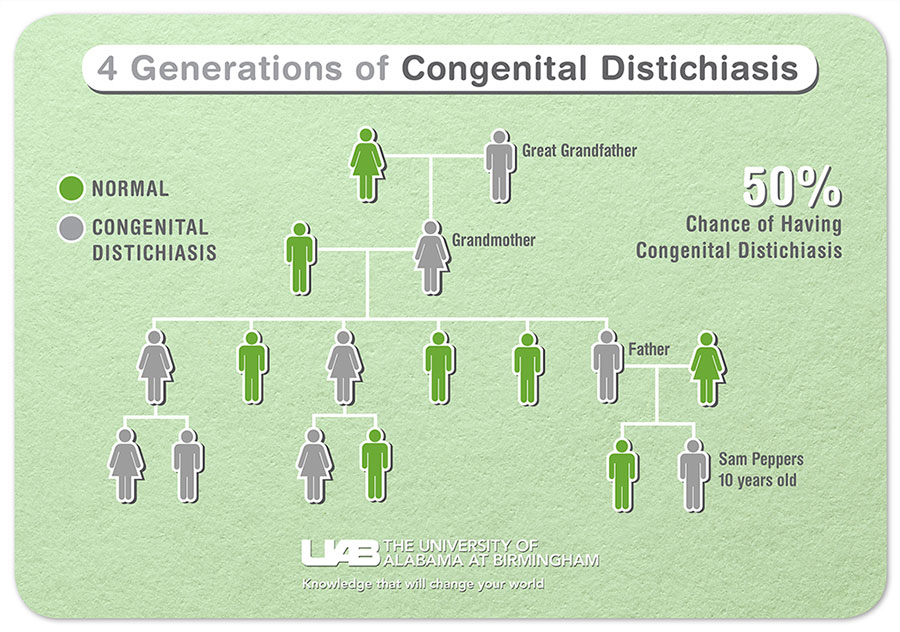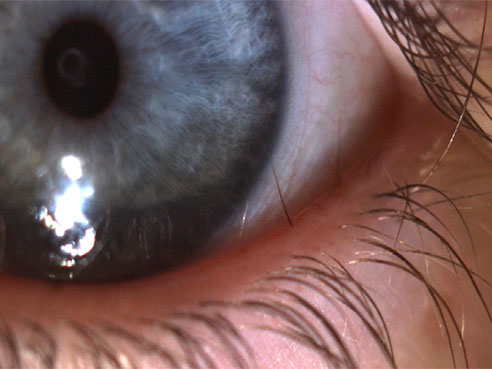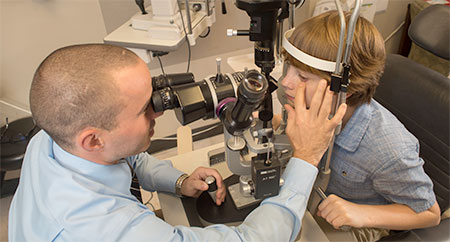 A rare hereditary disease with which a second row of eyelashes grows toward the eye has affected 10-year-old, Sam Peppers since he was an infant.
A rare hereditary disease with which a second row of eyelashes grows toward the eye has affected 10-year-old, Sam Peppers since he was an infant.
Sam’s father, Jon Peppers, had the hereditary condition, congenital distichiasis, giving Sam a 50 percent chance of experiencing the same eye condition. Jon and two of his six siblings had the extra row of lashes on each eye, along with his mother and grandfather. There is a 50 percent chance for everyone in the family to be diagnosed with the genetic eye condition.
“I was able to see the lashes when Sam was 6 months old,” said Tina McMillion, Sam’s mother. “When the sun hit his eyelids just right, I would catch glimpses of the little lashes that had started growing inward.”
Tina took Sam to see her optometrist, where she started her journey to find comfort for her son. At 18 months old, Sam had his first surgery to eliminate the inner row of lashes with a high-power microscope. The ophthalmologist would shine the light through the eyelid to dissect the hair follicles in an effort to get rid of the follicle so the hair would not grow back.
 A rare hereditary disease with which a second row of eyelashes grows toward the eye has affected 10-year-old, Sam Peppers since he was an infant.Sam is a fair-skinned child who does not have much pigment, making it difficult for the ophthalmologist to see all of the follicles.
A rare hereditary disease with which a second row of eyelashes grows toward the eye has affected 10-year-old, Sam Peppers since he was an infant.Sam is a fair-skinned child who does not have much pigment, making it difficult for the ophthalmologist to see all of the follicles.
While in the third grade, Sam had a second surgery once his hair follicles were better developed. The ophthalmologist was able to get some of the lashes; but there were still some left, making it uncomfortable for Sam.
As Sam has gotten older, the lashes have gotten thicker, coarser and longer, causing more problems. His eyes were always red, dry, scratchy and sensitive to light. Sam was constantly squinting, whether he was inside or outside. Tina tried to make him comfortable by giving him sunglasses and eye drops, leading him to the car when the sun was too bright.
“Sam has always been sensitive when it comes to his eyes,” Tina said. “It was hard for him to verbalize how uncomfortable it was because his eyes have always felt like that. He never knew what it was like to feel normal. I was scared that the extra lashes would cause more permanent damage to his eyes.”
She took him to several optometrists and specialists trying to find relief for Sam when they decided not to go through with a third surgery. At age 8, it was recommended that Sam wear contact lenses.
Sam was very anxious and would not let people near his eyes. Technicians worked with Sam, trying to get the contact lenses in and out, but they were unsuccessful.
After taking a break for about a year, Tina was determined to find relief for Sam. In August 2015, Tina was referred to University of Alabama at Birmingham Eye Care, where they met Daniel Deligio, O.D., cornea and contact lenses resident in the UAB School of Optometry.
 In August 2015, Sam was referred to UAB Eye Care where they met Daniel Deligio, O.D., cornea and contact lenses resident in the UAB School of Optometry.“When Sam first came in, he was very reserved and not socially engaged,” Deligio said. “Beyond the visible symptoms of his eyes, he had psychosomatic anxiety with anyone touching his eyelids. Anytime I would go to exam his eyes, he would pull back.”
In August 2015, Sam was referred to UAB Eye Care where they met Daniel Deligio, O.D., cornea and contact lenses resident in the UAB School of Optometry.“When Sam first came in, he was very reserved and not socially engaged,” Deligio said. “Beyond the visible symptoms of his eyes, he had psychosomatic anxiety with anyone touching his eyelids. Anytime I would go to exam his eyes, he would pull back.”
Deligio used a drop anesthetic to help make Sam more comfortable. Initially, he recommended scleral lenses, or large diameter contact lenses, to protect Sam’s cornea from the lashes. Good lid control and dexterity are required to get the scleral lenses into the eye. Sam did not have this control, so Deligio looked for another answer.
Soft contact lenses were recommended for Sam as a start to find relief. The first time Deligio put the lenses on Sam’s eyes, they used an anesthetic. With the help of his mother, they were able to get the lenses into Sam’s eyes. This was the first time he felt relief from the lashes.
Sam became comfortable with wearing contact lenses to protect his eyes and provide relief. The challenge became getting the lenses in and out by himself. He would become very anxious when inserting the lenses. Every time the lens came close to his eye, he would start breathing heavily, panic and drop everything, causing the lens to fall out.
“We would come in often, sometimes weekly, for Dr. Deligio to train Sam on putting in his contacts and taking them out,” Tina said. “They would schedule us last so that Dr. Deligio would have plenty of time to work with Sam. He would work with us for two hours at a time, sometimes running after hours.”
The constant encouragement set Sam’s treatment plan in action. He began wearing the monthly disposable contact lenses. Tina worked with him at home to help get the lenses in and out and clean them properly.
Two days after they went home with the lenses, Sam returned to UAB Eye Care, because one of the lenses had fallen out, and they were uncomfortable. Deligio prescribed daily contact lenses for Sam to wear one day at a time.
During one of his visits, Deligio noticed one of Sam’s eyes was extremely red. Sam had developed a sterile corneal ulcer from not taking the lenses out and cleaning them. Deligio learned that he had been leaving the lenses in for days at a time due to a fear of not getting the lenses back in. Sam had to go without the lenses for a few days to allow for the ulcer to heal.
Once Sam’s eye healed, Deligio put Sam back in the original lens approved for long-term wear. Sam was instructed to take it out every day and clean the lens. Five months later, the lenses were comfortable; but Sam was experiencing mucus buildup on the lens.
“We did a unique treatment where he would wear a daily disposable lens during the day, then throw it away when he would put in the monthly lens before going to sleep,” Deligio said. “This would force him to take the lens out, clean it and put a fresh lens in. He reported much better comfort and no mucus buildup, and that is what he is in currently.”
No longer fighting the distraction of dry, itchy eyes, Sam is more comfortable and has even improved in his school work.
“We appreciate Dr. Deligio,” Tina said. “This has truly been life-changing for Sam. He now walks with his head up and eyes open. He is able to see comfortably.”